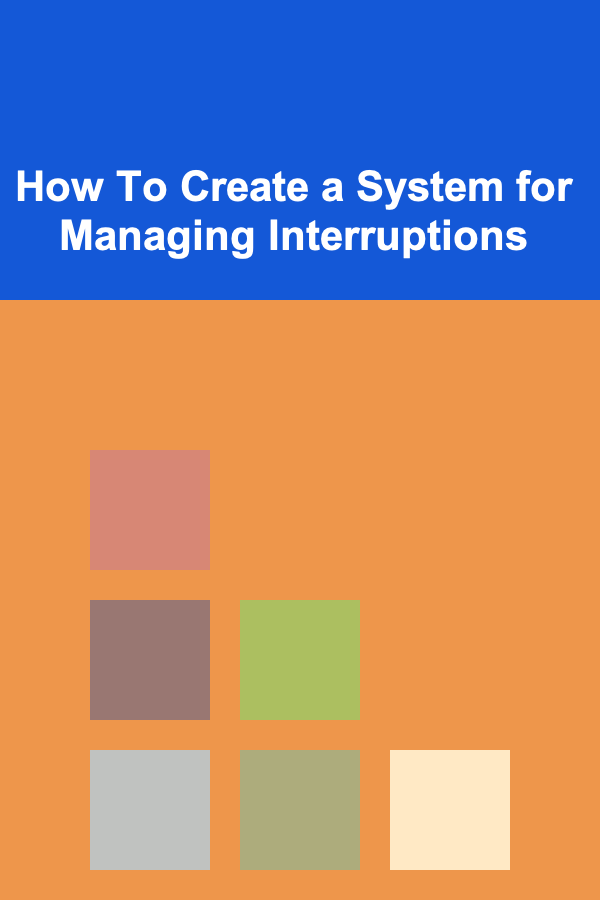
How To Create a System for Managing Interruptions
ebook include PDF & Audio bundle (Micro Guide)
$12.99$11.99
Limited Time Offer! Order within the next:

Interruptions are a constant presence in both personal and professional lives. From the moment we wake up to the time we go to bed, interruptions can take many forms---whether it's a phone call, a message, a colleague at the door, or even internal distractions like wandering thoughts. They can derail productivity, create frustration, and hinder focus, making it essential to manage them effectively.
Creating a system for managing interruptions is not just about minimizing distractions; it's about understanding the types of interruptions you face, recognizing the impact they have on your productivity, and designing a framework that helps you handle them efficiently. In this article, we will explore the key strategies and techniques for building an effective system to manage interruptions and maintain focus.
Understanding Interruptions
Before creating a system to manage interruptions, it's important to understand what they are and why they occur. Interruptions can be categorized into several types:
1. External Interruptions
External interruptions are caused by factors outside of yourself. These might include:
- Phone calls or messages: Notifications from friends, colleagues, or clients.
- Emails: Constant influx of emails can be disruptive if not managed properly.
- People walking into your office or workspace: Whether it's a colleague or a family member, interruptions from others can break your concentration.
- Meetings: Scheduled meetings or unexpected ones can disrupt your workflow.
2. Internal Interruptions
Internal interruptions come from within you. These include:
- Mental distractions: These are thoughts, anxieties, or worries that pull your attention away from the task at hand.
- Procrastination: You may feel tempted to start tasks that aren't urgent or important, diverting your focus.
- Hunger, fatigue, or discomfort: Physical factors like hunger or being tired can also disrupt your focus.
3. Environmental Interruptions
Sometimes, external factors like noise, temperature, or general chaos in your surroundings can interfere with your concentration. For instance:
- Noise pollution: Background sounds like traffic, chatter, or construction work can be constant distractions.
- Work environment: A cluttered desk or a chaotic workspace can make it difficult to focus.
4. Digital Interruptions
In today's digital world, technology can be a major source of interruption. These include:
- Social media notifications: Alerts from platforms like Facebook, Instagram, or Twitter can be major time sinks.
- News updates: Constant news cycles can pull your attention away from tasks.
- App notifications: Even unrelated apps can ping you with reminders or updates.
The Impact of Interruptions on Productivity
Interruptions can significantly impact productivity, both in the short term and long term. The primary consequences include:
1. Loss of Focus
Interruptions, especially frequent ones, prevent deep focus. When you're interrupted, it can take several minutes to get back to the task at hand. In fact, research suggests that it can take up to 23 minutes to regain full focus after an interruption. This constant loss of focus adds up, leading to decreased productivity over time.
2. Task Switching and Cognitive Load
When you switch between tasks, your brain has to work harder to refocus and switch gears. This task-switching comes with a cognitive cost, as it increases mental fatigue and makes it more difficult to perform well on either task.
3. Increased Stress
Interruptions increase stress because they create a sense of urgency. Every time you're interrupted, you feel like you're falling behind or that you need to catch up. This leads to anxiety and a feeling of being overwhelmed.
4. Lower Quality of Work
Due to the mental strain caused by frequent interruptions, the quality of your work may also decline. When you're constantly switching between tasks or fighting distractions, you're less likely to give your best effort, leading to subpar results.
Step-by-Step Guide to Creating a System for Managing Interruptions
Step 1: Identify Your Interruptions
The first step in managing interruptions is to identify what they are. Track your interruptions for a week and categorize them into internal, external, environmental, and digital. By doing so, you'll be able to clearly see the types of distractions that are most prevalent in your life.
Here are some questions to ask yourself when tracking interruptions:
- How many times during the day am I interrupted?
- Are these interruptions internal (like thoughts) or external (like phone calls)?
- What's the average length of each interruption?
- How does each interruption impact my productivity?
Step 2: Prioritize Your Tasks
Once you've identified the interruptions, the next step is to prioritize your tasks. Use a method such as the Eisenhower Matrix, which helps you categorize tasks into four categories based on urgency and importance:
- Urgent and Important: Tasks that need immediate attention (e.g., deadlines, meetings).
- Not Urgent but Important: Tasks that require focus but don't have an immediate deadline (e.g., strategic planning, deep work).
- Urgent but Not Important: Tasks that need to be done quickly but don't add significant value (e.g., answering some emails).
- Not Urgent and Not Important: Tasks that aren't critical and can be deferred or eliminated (e.g., browsing social media).
By categorizing your tasks, you can see which ones are truly important and deserve your attention and which ones can be put aside or delegated. This helps you handle interruptions with greater clarity---knowing which tasks are worth pausing for and which can be ignored.
Step 3: Designate 'Focus' Blocks
A key strategy for managing interruptions is scheduling dedicated focus blocks throughout the day. These blocks of time are for uninterrupted, deep work. Consider using techniques such as:
- Time blocking: Set aside specific chunks of time for deep work. For example, block out 9 AM to 11 AM for focused work on a project, with no distractions.
- The Pomodoro Technique: This involves working in 25-minute intervals, followed by a 5-minute break. After completing four intervals, take a longer 15--30-minute break. The Pomodoro Technique helps build deep focus while ensuring you get regular breaks.
During these blocks, eliminate or minimize any possible interruptions by turning off phone notifications, closing unnecessary tabs on your computer, and telling others not to disturb you.
Step 4: Set Boundaries with Others
Setting boundaries with coworkers, friends, and family members is essential for managing interruptions. Here's how you can establish clear boundaries:
- Establish 'office hours' or designated work times: Let people know when you're available to chat and when you need uninterrupted time. For example, you might set office hours for questions and discussions, but outside of those hours, you require quiet time to focus.
- Create a visual cue for focus time: Use signals like wearing headphones, putting a "do not disturb" sign on your door, or having a dedicated workspace to let others know you're in a focused state.
- Communicate proactively: If you know you will be unavailable, inform others in advance. This can prevent unnecessary interruptions when they're looking for you.
Step 5: Handle Digital Interruptions
Managing digital interruptions requires a bit of digital decluttering. Here are some strategies:
- Mute notifications: Turn off non-essential notifications on your phone, email, and social media apps.
- Use tools for focused work: Apps like Focus@Will , Freedom , or RescueTime can block distracting websites or track your time to keep you focused on the task at hand.
- Check emails at set times: Instead of responding to emails as soon as they come in, set specific times during the day to check your inbox. This reduces the constant distraction of incoming messages.
Step 6: Implement Mindfulness Techniques for Internal Interruptions
For internal distractions---such as wandering thoughts, stress, or fatigue---consider implementing mindfulness practices. These can help you stay grounded and focused. Here are a few techniques:
- Deep breathing exercises: Take a few moments to breathe deeply, inhaling through your nose and exhaling through your mouth. This can help calm your mind and reduce internal distractions.
- Meditation: Even short sessions of meditation (5--10 minutes) can help clear your mind and improve focus.
- Mindful breaks: Take intentional breaks where you step away from your work to re-center yourself, especially if you feel overwhelmed.
Step 7: Review and Adapt
After you've implemented your system for managing interruptions, it's important to regularly review and adapt it. Interruptions are dynamic, and your system may need tweaking over time. Regularly evaluate:
- How effective your strategies are at minimizing interruptions.
- Whether new types of interruptions have arisen and how to manage them.
- If you're achieving a good balance between focus time and relaxation.
Conclusion
Creating a system for managing interruptions requires an intentional approach. By identifying your sources of disruption, prioritizing tasks, establishing focus blocks, setting boundaries, managing digital distractions, and addressing internal interruptions, you can create an environment that fosters productivity and deep work. Remember, there's no one-size-fits-all solution; it's about finding the strategies that work best for you and continuously refining your system.
Ultimately, mastering the art of managing interruptions leads to improved productivity, reduced stress, and a greater sense of accomplishment. In a world full of distractions, learning to focus and protect your time is one of the most valuable skills you can develop.

How to Reduce Tenant Turnover and Keep Your Rental Profitable
Read More
How to Stay Relevant in a Rapidly Changing Remote Job Market
Read More
How to Store Your Holiday Decorations Without Clutter
Read More
How To Master Time Management for Team Leaders
Read More
How To Master 3D Printing for Robotics Components
Read More
10 Tips for Creating a Sensory-Friendly Classroom Environment
Read MoreOther Products

How to Reduce Tenant Turnover and Keep Your Rental Profitable
Read More
How to Stay Relevant in a Rapidly Changing Remote Job Market
Read More
How to Store Your Holiday Decorations Without Clutter
Read More
How To Master Time Management for Team Leaders
Read More
How To Master 3D Printing for Robotics Components
Read More